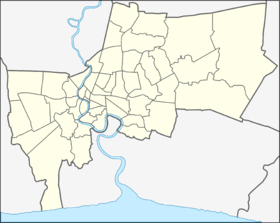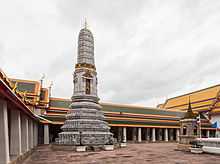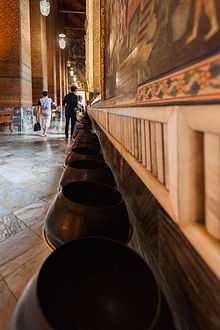Wat Pho
| Wat Pho | |
|---|---|
|
View of the Reclining Buddha | |
 Wat Pho Location within Bangkok | |
| Information | |
| Denomination | Theravada Buddhism |
| Founded | 1781 A.D.[1] |
| Founder(s) |
King Buddha Yodfa Chulaloke (Rama I) |
| Country | Thailand |
| Coordinates | Coordinates: 13°44′47″N 100°29′37″E / 13.74639°N 100.49361°E |
| Website | www.watpho.com |
Wat Pho (Thai: วัดโพธิ์, IPA: [wát pʰoː]) is a Buddhist temple in Phra Nakhon district, Bangkok, Thailand. It is located in the Rattanakosin district directly adjacent to the Grand Palace.[2] Known also as the Temple of the Reclining Buddha, its official name is Wat Phra Chettuphon Wimon Mangkhlaram Ratchaworamahawihan[3] (Thai: วัดพระเชตุพนวิมลมังคลารามราชวรมหาวิหาร; IPA: [wát pʰráʔ tɕʰêttupʰon wíʔmon maŋkʰlaːraːm râːttɕʰawɔːráʔmahǎːwíʔhǎːn]). The temple is also known as the birthplace of traditional Thai massage.[4]
History
Wat Pho is named after a monastery in India where Buddha is believed to have lived.[5] Prior to the temple's founding, the site was a centre of education for traditional Thai medicine, and statues were created showing yoga positions. An enormous Buddha image from Ayuthaya's Wat Phra Si Sanphet was destroyed by the Burmese in 1767; King Rama I (1782-1809 A.D.) incorporated its fragments to build a temple to enlarge and renovate the complex.[6] The complex underwent many changes in the next 260 years. Under King Rama III (1824-1851 A.D.), plaques inscribed with medical texts were placed around the temple.[7] These received recognition in the Memory of the World Programme launched by UNESCO on February 21, 2008.[8] Adjacent to the building housing the Reclining Buddha is a small raised garden, the centrepiece being a bodhi tree which is believed to have been propagated from the original tree in India where Buddha sat while awaiting enlightenment. The temple was created as a restoration of an earlier temple on the same site, Wat Phodharam, with the work beginning in 1788. The temple was restored and extended in the reign of King Rama III, and was restored again in 1982.
The Temple Complex

Wat Pho is one of the largest and oldest wats in Bangkok (with an area of 50 rai, 80,000 square metres),[9] and is home to more than one thousand Buddha images, as well as one of the largest single Buddha images of 160 ft length:[10] the Reclining Buddha (Phra Buddhasaiyas, Thai พระพุทธไสยาสน์). The Wat Pho complex consists of two walled compounds bisected by Soi Chetuphon running east–west. The northern walled compound is where the reclining Buddha and massage school are found. The southern walled compound, Tukgawee, is a working Buddhist monastery with monks in residence and a school. Outside the temple, the grounds contain 91 chedis (stupas or mounds), four viharas (halls) and a bot (central shrine). 71 chedis of smaller size contains the ashes of the royal family, and 21 large ones contain the ashes of Buddha.[11] The four chedis are dedicated to the four Chakri kings.[4] The temple has sixteen gates around the complex guarded by Chinese giants carved out of rocks.[5] These statues were originally imported as ballast on ship trading with China.[11]
The outer cloister has images of 400 Buddhas out of the 1200 originally bought by king Rama V. In terms of architecture, these are varied in different styles and postures, but these are evenly mounted on matching gilded pedestals.[5] The main temple is raised in marble platform punctuated by mythological lions in the gateways. The exterior balustrade has around 150 depictions of the epic, Ramakien, the ultimate message of which is transedence from secular to spiritual dimensions.[5]
Reclining Buddha


The image of reclining Buddha is 15 m high and 43 m long with his right arm supporting the head with tight curls on two box-pillows of blue, richly encrusted with glass mosaics.[5] The 3 m high and 4.5 m long foot of Buddha displays are inlaid with mother-of-pearl. They are divided into 108 arranged panels, displaying the auspicious symbols by which Buddha can be identified like flowers, dancers, white elephants, tigers and altar accessories.[5] Over the statue is a seven tiered umbrella representing the authority of Thailand.[11] There are 108 bronze bowls in the corridor indicating the 108 auspicious characters of Buddha. People drop coins in these bowls as it is believed to bring good fortune, and to help the monks maintain the wat.[4] Though the reclining Buddha is not a pilgrimage centre, it remains an object of popular piety.[11]

Thai Massage
The temple is considered the first public university of Thailand, teaching students in the fields of religion, science and literature through murals and sculptures.[4] In 1962 a school for traditional medicine and massage was established.[12] The temple is home to one of the earliest Thai massage schools. Traditional Thai massage and medicine is taught at the Traditional Medical Practitioners Association Center, an open air hall outside the temple.[4] For Thai massage therapists, the medical inscription inside the temple acts as a base for treatment. There are 60 plaques inscribed, 30 each for the front and back of human body. Therapeutic points and energy pathways known as sen were engraved and the explanations were carved on the walls next to the plaques.[13] Full research on the diagrams is still not completed - the derivation so far is that the figures represent relationships between anatomical locations and effects produced by treatment at those locations.[14]
Notes
- ↑ Spooner, Andrew; Hana Borrowman; William Baldwin (2011). Footprint Thailand. UK: www.footprintbooks.com. pp. 86–87. ISBN 978-1-904777-94-6.
- ↑ Liedtke, Marcel (2011). Thailand- The East (English Edition). Norderstedt: Books on Demand GmbH. p. 57. ISBN 978-3-8423-7029-6.
- ↑ "พระนอนวัดโพธิ์" [The Reclining Buddha at Wat Pho]. Royal Institute of Thailand. 2012-12-27. Retrieved 2013-01-13.
วัดพระเชตุพนวิมลมังคลาราม (อ่านว่า พฺระ-เชด-ตุ-พน-วิ-มน-มัง-คฺลา-ราม) ["วัดพระเชตุพนวิมลมังคลาราม (pronounced: wat-phra-chet-tu-phon-wi-mon-mang-khla-ram)"]
- ↑ 4.0 4.1 4.2 4.3 4.4 Emmons 2010, pp.126-127
- ↑ 5.0 5.1 5.2 5.3 5.4 5.5 O'Neil 2008, pp. 116-118
- ↑ Beek, Steve Van; Luca Invernizzi (2001). The arts of Thailand. p. 26.
- ↑ Ridout, Lucy; Paul Gray (2009). The Rough Guide to Thailand's Beaches & Islands. India: Rough Guides. ISBN 9781405380096.
- ↑ Thailand's Government Public Relations Department
- ↑ Emmons, Ron (2008). Top 10 Bangkok. New York: DK. p. 58. ISBN 9780756688509.
- ↑ Norwich, John Julius (2001). Great architecture of the world. USA: De Capo Press Inc. p. 266. ISBN 0-306-81042-5.
- ↑ 11.0 11.1 11.2 11.3 Brockman, Norbert C. (2011). Encyclopedia of Sacred Places. California: ABC-CLIO, LLC. pp. 302–304. ISBN 978-1-59884-655-3.
- ↑ O'Neil 2008, p. 120
- ↑ Apfelbaum 2004, p. 30
- ↑ Apfelbaum 2004, p. 38
References
- Apfelbaum, Ananda (2004). Thai massage: sacred bodywork. New York: Penguin Group (USA) Inc. ISBN 1-58333-168-9.
- Emmons, Ron (2010). Frommer's Thailand. NJ: Wiley Publishing Inc. ISBN 978-0-470-53766-4.
- O'Neil, Maryvelma Smith (2008). Bangkok: a cultural history. New York: Oxford University Press. ISBN 978-0-19-534251-2.
External links
| Wikimedia Commons has media related to Wat Pho. |
| Thai Wikisource has original text related to this article: |
